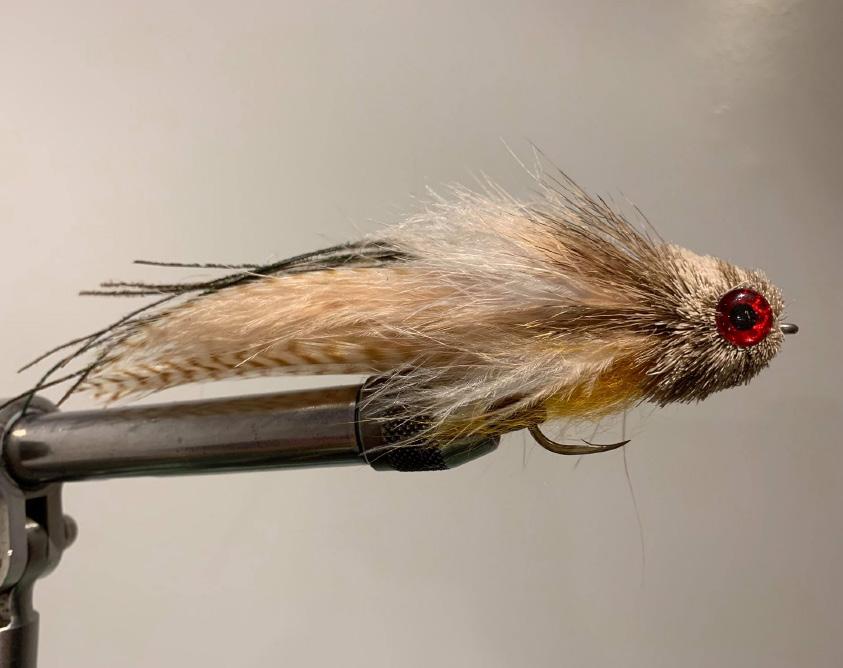
4 minute read
TIE 'N FLY BOX
F LY B O X THE FLIES BY
Giant Killers As tied by Capt. Gavin Platz
A REAL LEGEND – BILL CATHERWOOD
Bill Catherwood was one of the New England area’s originals of the saltwater fly tying scene. He had articles written about his innovative saltwater fly patterns as far back as the 1950’s. His series of Big Fly patterns were named the “Giant Killers “ because Bill found it very hard to get the right sized feathers & colours of feathers to tie his patterns so he started raising his own birds & dying his own feathers to get just the right colours for his “Giant Killers”. He even raised his own black-faced sheep, so he had the right wool to create his large patterns. He was infamous for bringing live roosters to fishing and outdoor shows where he would be tying flies. I doubt that would be allowed these days! Bill wrote many articles for United Fly Tyers Roundtable magazine on the use of Partridge, Duck, Grouse and long saddle hackles for tying trout flies. He would happily share his ideas and teach his techniques to anybody who would listen.
Bill Catherwood was one of the first, if not the first, to bring the technique of spun deer hair to saltwater fly tying from the Trout & Salmon fly tying arena. He was innovative and progressive during the 1950’s, his Giant Killer series or his oversized baitfish imitations, which are a mixture of marabou, hackle and hair influenced entire generations of saltwater fly tyers.
I doubt if any fly tyer can claim ‘Complete Originality’ in the design of a fly pattern. When we all sit in front of our fly vice to create, we borrow ideas from all the fly dressers who have come before us and Bill Catherwood is no exception. The Giant Killers are versions of Muddler Minnows but tied huge. The Muddler Minnow is one of those archetypal fly patterns that reinvents itself every few years. It was developed in the late 1930’s by Don Gapen from Anoke, Minnesota. It represented a bot
tom feeder which looked more like a lizard than a fish called a sculpin. The pattern very quickly evolved into countless variations sporting marabou or Zonker wings and even spun wool heads for better sink-ability. Some of the modern day streamers like Kelly Galloup’s Zoo Cougar, Armand Courchaine’s Mud Deceiver, Eric Leiser’s Angus and of course Lou Tabory’s Snake fly are all variations of the Muddler theme, a spun head with different wing and tail materials.
Bill Catherwood passed away in November 2013 at the age of 88, he was a WW2 Veteran who earned the distinction of a Demolition Expert, Rifle Sharpshooter & a Machine Gun Marksman. A member of the 150th Combat Engineers who personally earned six Bronze Stars.
A real life war hero.
He was very well respected in the fly fishing industry and was a co-founder of the United Fly Tyers Organization in 1959, the oldest fly tying organisation in the USA and he also received a Lifetime Achievements Award from the Federation Of Flyfishers for his contribution to our sport.
This fly tie is not an exact Catherwood tie but my own take on what he was aiming at when he developed his Giant Killer range.
Lets get started & I hope you enjoy it,
Have fun
Gavin
MATERIALS:
Thread - Flat waxed Nylon
Tail - Artic Fox fur orange, Marabou Plume tan & Grey
Over Wing – Ewing Hackle Tan Grizzley
Head – Deer Belly Hair Natural
Eyes – 3D stick on to suit
Step 1 - Tie in a clump of Artic Fox at the bend of the hook.

Step 2 - Tie in a Tan Marabou Plume in flat wing style & surround that feather with clumps of Grey Marabou. Tie in a small bunch of Artic Fox underneath.

Step 3 - Tie in 6 Hackles flat wing style, till they surround the marabou tail. To the length required.

Step 4 - Tie in more clumps of Marabou.

Step 5 - Tie in 6 pieces of Peacock Hurl the length of the fly.

Step 6 - Sin Deer Hair to fill the rest of the hook shank and trim to the desired shape.

Step 7 - Add 3D eyes to suit

You can see Catherwood’s style of tying not only makes a great fish catching fly but also makes a pretty looking fly. I believe it’s really important to try and make the flies you tie to a standard that makes you think they look fantastic. If you don’t think that, then the fly you have just tied will never get tied on to your tippet. A fly must look good to an angler before it will ever catch a fish, fact of life I’m afraid.
So have fun tying!





